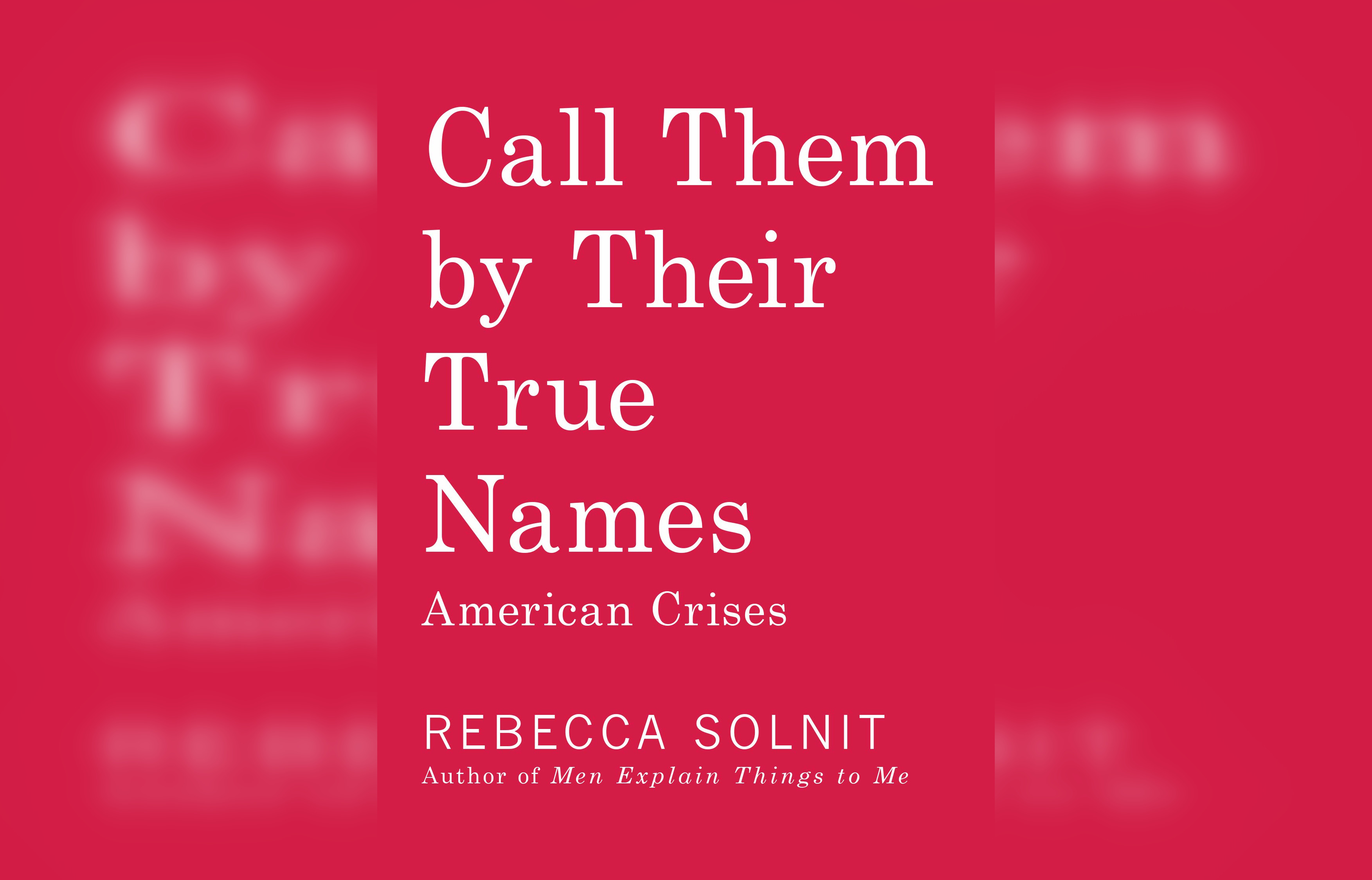I first read Rebecca Solnit in San Rafael, just north of San Francisco’s Golden Gate Bridge. It’s the perfect place to read her: San Francisco is a place she currently calls home and the Bay Area has influenced her writing since at least her days as a graduate student in journalism at UC Berkeley in the mid-1980s. At the behest of my boss, I read her seminal feminist essay, “Men Explain Things to Me,” on my work computer. It was from this piece that the term “mansplaining” was spawned, though Solnit herself didn’t coin it. To write an essay which rings true to so many individuals’ experience as to popularize a new word is a feat, and Solnit has already accomplished it.
Her newest work, Call Them by Their True Names: American Crises (and Essays), is a collection of essays that deals with language in a more direct way. It delves into the linguistics and politics of the Trump era that are meant to challenge imprecise or avoidant uses of language. The strongest essays in the collection center around the San Francisco Bay Area: “Death by Gentrification: The Killing of Alex Nieto and the Savaging of San Francisco” and “Bird in a Cage: Visiting Jarvis Masters on Death Row.”
Call Them by Their True Names is a nod to the power of names and naming. In Solnit’s foreword to the book, she writes that this collection is bound by its fidelity to the precision of language: “Being careful and precise about language is one way to oppose the disintegration of meaning, to encourage the beloved community and the conversations that inculcate hope and vision. Calling things by their true names is the work I have tried to do in the essays here.” She explains that names have power and “calling things by their true names cuts through the lies that excuse, buffer, muddle, disguise, avoid, or encourage inaction, indifference, obliviousness.”
These essays cover such varied subjects as Native American creation myths, Donald Trump, Hillary Clinton, the #metoo movement, voter suppression, cynicism, climate change, police shootings, incarceration, gentrification, Standing Rock, investigative journalism and the nature of history. Solnit bravely tackles the crises which define America today and imperil our humanity as well as our survival.
The main ideas behind the book about the precision of language and power of naming are necessary and poignant, but the reality of Solnit’s essays does not always live up to this ideal. Solnit’s use of language can itself feel imprecise and untested; I often got the sense I was reading a writer who had already made up their mind without room to change it. It’s hard to open oneself up as a reader on a journey when a writer does not seem to be on one themselves.
I have not always felt this in Solnit’s work–for example with A Field Guide to Getting Lost or “Men Explain Things to Me,” but I think a crucial difference between reading those works and Call Them by Their True Names is Solnit’s reliance on personal experience. In Call Them by Their True Names, there was less a reliance on personal narratives to demonstrate her point of view and more a reliance on ideology. This can feel automatic and impersonal when navigating subjects as monolithic as the crises Solnit has taken on. The contents of each essay could have easily been expanded to fill a book on their own.
For example, her essay “Milestones in Misogyny” about the 2016 presidential election, is sympathetic to Clinton to the point of oversimplifying the narrative. Solnit writes, “one might argue [Clinton] lost because of the disenfranchisement of millions of people of color through long-plotted Republican strategies…or because of the FBI’s intervention in the election; or because of years of negative media coverage; or because of foreign intervention designed to sabotage her chances; or because of misogyny.” All valid points but there is no mention in the essay of the DNC’s undermining of Sanders’ campaign in the 2016 democratic nominating process, the bias of DNC leadership in favor of Clinton and coordination between the Clinton campaign and the DNC in this undermining. Solnit’s omission of these nuances which further complicate the narrative of Clinton’s presidential ambitions made me feel less inclined to trust Solnit as a narrator. If one ventures to tell the truth, one must tell the whole truth.
Another example of this selective storytelling comes in her essay about voter suppression, “Twenty Million Missing Storytellers.” In this work, Solnit argues that powerful men who were accused of sexual harassment negatively shaped the narrative around Clinton. Solnit writes, “[S]ome of the most powerful men in the U.S. media had been exposed as sexual harassers, and these men—including Charlie Rose, Matt Lauer, and Mark Halperin—had shaped the hostile narrative around Hillary Clinton.” This may be true, but the truths left out also shape the narrative. Solnit neglects to mention Harvey Weinstein’s well-known support of Clinton and his financial contributions to her campaign. This lack of nuance occurred at various points throughout the book and detracted from valid points Solnit was making.
The essays that work the best in this collection are the closest to home for Solnit: the police killing of Latino Bernal Heights resident Alex Nieto and the incarceration of Jarvis Masters, a Buddhist inmate with abundant wisdom, on death row at San Quentin. Solnit physically moves through these spaces and knows their landscapes well. Her longtime knowledge of the San Francisco bay area and its communities comes through and breathes a freshness and complexity into her advocacy for vulnerable populations. These essays felt more like stories rather than vehicles for rhetoric, although there is of course politics wrapped up into both. Stories, however, offer the reader the opportunity to travel along with Solnit and make their own judgments based on what they see whereas rhetoric often feels as if Solnit has made up her mind on what a reader should take away.
What Solnit fights for is admirable. She is clearly concerned about America’s most vulnerable populations: the homeless, the incarcerated and minorities. However, even as advocates for these communities myself (and a member of the latter), I felt Solnit lacked fairness in writing about them. Humanizing a subject means including both the good and the bad, essentially making them true to life. The moment you scrub subjects clean and present them as innocent because of your own concerns or advocacy, you’ve failed them. To be human means to embody both the light and the darkness, both the good and the bad.
I often felt there was a categorical assigning of good and bad in this book based on labels such as conservative/liberal; rich/poor; and minority/white. It reminded me–more than once–of the Shakespeare line: “what’s in a name? that which we call a rose/ by any other name would smell as sweet,” a sort of shorthand for not being wrapped up in labels or names but the content behind a name.
There can be plenty taken for granted in names, and an abundance of content to explore behind a name. At times, I felt Solnit’s concern with names was a hindrance to a deeper exploration of the ideas beyond names. For Solnit, can a rich person be generous, for example? Are conservatives always misguided? Can liberals be corrupt? When we don’t use nuance in these terms, we contribute to the assumptions and division currently plaguing our nation.
I am all for calling them by their true names, but inherent in that statement is a plethora of terms taken for granted. Who is them? Who is us? Who gets to be the arbiter of truth? And what–truly–is in a name?
Photo Credit: Courtesy Haymarket Books




